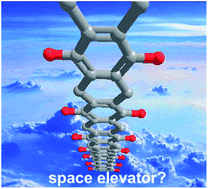High-modulus all-carbon ladder polymer of hydroquinone and formaldehyde that bridges the gap between single-strand polymers and graphene nanoribbons†
Abstract
The high-strength and novel electronic properties of all-carbon macromolecules, as represented by carbon nanotubes and graphenes, originate from their conjugated all-carbon structures. The synthetic polymers with conjugated all-carbon ladder structures would partially inherit the excellent properties of carbon nanotubes and graphenes. However, such polymers as polyacene (PAC) are particularly difficult to synthesize. In this paper, we demonstrate the facile synthesis of an all-carbon straight ladder polymer from a one-pot polycondensation reaction between hydroquinone and formaldehyde. This polymer could be oxidized and isomerized to a fully aromatic all-carbon ladder structure identical to that of PAC. Such a conjugated all-carbon ladder structure will provide a long-sought-after model for investigations on the mechanical and electronic properties of PAC-like ladder structures. The chain and skeleton moduli of this polymer were calculated to be up to 50% (528 GPa) and 89% (932 GPa), respectively, of that of CNT(5,5) (1046 GPa).


 Please wait while we load your content...
Please wait while we load your content...